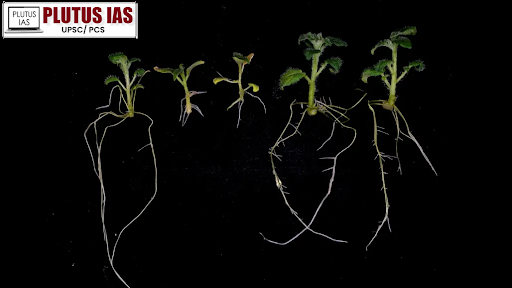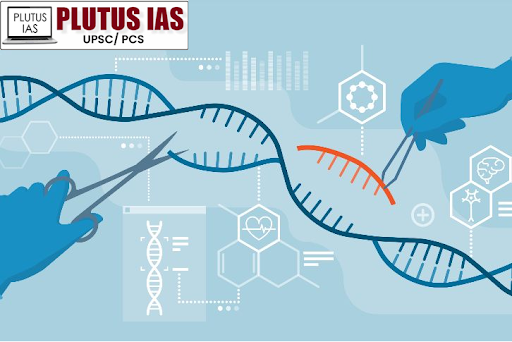20 Nov Gene Editing in Potatoes: A Path to Reducing Greenhouse Gas Emissions In Agriculture”
This article covers “Daily Current Affairs” and topic details of Gene Editing in Potatoes: A Path to Reducing Greenhouse Gas Emissions In Agriculture”
Syllabus mapping:
GS-3: Science and Technology: Recent development in the field of biotechnology.
For Prelims:
What is Gene Editing, CRISPR-9 cis technology? What are the GM crop and its regulations in India?
For Mains:
What is the recent development in potato-eating technology, its significance, challenges in the use of this technology, and the way forward?
Why in the News:
Researchers have discovered that the StCDF1 gene, which controls potato growth, also regulates nitrogen management. This breakthrough could lead to potato varieties requiring less fertilizer, reducing costs and environmental impact. As potatoes are the third-most consumed food globally, this finding offers a promising solution to enhance food security and address agricultural challenge

What is Gene Editing?
Gene editing is a biotechnological method that allows scientists to modify an organism’s DNA precisely. Techniques such as CRISPR-Cas9 enable researchers to add, remove, or alter specific genetic material within an organism’s genome. This technology has revolutionized genetic research and agriculture by providing a way to enhance desirable traits, such as disease resistance, drought tolerance, and nutrient efficiency, without introducing foreign DNA.

Gene Editing in Potato:
Potato editing refers to the application of gene editing techniques specifically to enhance the traits of potato plants. In this case, researchers are focusing on the StCDF1 gene, which regulates tuber growth and nitrogen management. By disabling or modifying this gene, scientists aim to create potato varieties that can thrive in low-nitrogen environments, thereby reducing the need for chemical fertilizers. This approach not only has the potential to improve the health and yield of potato crops but also addresses environmental concerns related to fertilizer runoff and groundwater pollution.
Significance of the New Discovery:
Environmental Benefits: By developing potato varieties that need less nitrogen fertilizer, this research helps reduce environmental pollution, particularly from excess fertilizers contaminating groundwater.
Cost Reduction for Farmers: Lower fertilizer requirements lead to significant cost savings, making potato farming more affordable, especially for smallholder farmers who rely heavily on nitrogen fertilizers.
Improved Food Security: Potatoes, a staple food for millions, can be grown more efficiently with higher yields and better-quality tubers, contributing to enhanced food security globally.
Advancement in Agricultural Biotechnology: This breakthrough highlights the potential of gene editing and traditional breeding to address critical agricultural challenges like nutrient uptake and crop resilience.
Sustainability in Agriculture: The research offers a solution for sustainable agricultural practices, reducing reliance on chemical fertilizers and minimizing ecological damage, thus promoting long-term agricultural health.
Potential for Broader Crop Improvement: Techniques developed for potatoes can be applied to other crops with similar nitrogen efficiency issues, improving overall agricultural productivity.
Support for Global Agricultural Innovation: This discovery sets the stage for further advancements in agricultural biotechnology, leading to more resource-efficient and resilient farming systems worldwide.
Challenges of Potato Gene Editing
High Genetic Diversity: The highly heterozygous nature of potatoes makes it difficult to achieve consistent gene-editing results, especially in India’s diverse agro-climatic conditions.
Tetraploid Complexity: Potatoes’ tetraploid nature, with four sets of chromosomes, complicates precise gene editing, slowing the development of improved crop varieties.
Polygenic Traits: Many critical traits like disease resistance and tuber quality are controlled by multiple genes, requiring complex multi-gene editing strategies.
Off-Target Effects: Gene-editing tools like CRISPR/Cas9 can cause unintended genetic changes, potentially impacting crop stability and safety in Indian agricultural systems.
Regulatory Challenges: India’s regulatory framework for genetically modified organisms (GMOs) is evolving, which may delay the approval and commercialization of gene-edited crops.
Public Skepticism: Indian consumers often view genetically modified crops with suspicion, requiring extensive efforts to build trust and awareness about the benefits of gene editing.
Low Transformation Efficiency: Achieving efficient transformation and regeneration of potato plants remains a technical challenge for Indian researchers, affecting large-scale adoption.
Environmental Impact: The ecological effects of introducing gene-edited varieties into India’s environment need to be carefully studied through long-term research.
High Costs: Developing gene-edited crops requires substantial financial investment, which can be a barrier for smaller research institutions and farmers in India.
Intellectual Property Issues: Disputes over the ownership of gene-editing technologies and their applications can hinder collaboration and innovation in the Indian agricultural sector.
Strategies to Advance Potato Gene Editing in India
Establish Regulatory Frameworks: Define clear guidelines distinguishing gene-edited crops from GMOs, with oversight by the Genetic Engineering Appraisal Committee (GEAC), aligning with frameworks like the Biosafety Guidelines, 1989.
Form Advisory Committees: Create a Gene Editing Advisory Committee to evaluate safety and ethics, inspired by bodies like the National Biodiversity Authority (NBA).
Promote Public Engagement: Build trust through educational campaigns and a Public Engagement Task Force, modeled on the Biotech Consortium India Limited (BCIL).
Enhance Collaborative Research: Establish a National Gene Editing Research Consortium, akin to the National Innovation Foundation (NIF), to foster partnerships and innovation.
Provide Funding: Support gene-editing research through initiatives like Rashtriya Krishi Vikas Yojana (RKVY) or new schemes for nitrogen-efficient potatoes.
Develop Risk Protocols: Standardize risk assessments, overseen by a global body inspired by the Cartagena Protocol on Biosafety.
Facilitate Global Cooperation: Form a Global Gene Editing Alliance, similar to the International Treaty on Plant Genetic Resources for Food and Agriculture ITPGRFA, for harmonized standards and research collaboration.
Monitor Outcomes: Set up a Gene Editing Monitoring Board, akin to the National Gene Bank, to evaluate field impacts and ensure transparency.
Conclusion:
Gene editing in potatoes can boost sustainability, cut greenhouse gas emissions, and strengthen global food security. Addressing technical, regulatory, and ethical challenges while fostering public trust is vital. Collaborative efforts and a balanced focus on safety, sustainability, and farmer benefits can pave the way for resilient agricultural systems.
Download Plutus IAS Current Affairs (ENG) 20th Nov 2024
Prelims Question:
Q. With reference to gene editing in potato cultivation, consider the following statements:
1. Gene editing techniques like CRISPR-Cas9 allow for the precise modification of an organism’s DNA.
2. The StCDF1 gene can be modified to improve nitrogen uptake in potatoes, leading to more efficient fertilizer use.
3. Gene editing introduces foreign DNA into the organism’s genome to achieve desired traits.
How many of the above-given statements are correct?
A. Only one
B. Only two
C. All three
D. None
ANSWER: B
Mains question:
Biotechnology has revolutionized agriculture in India, but it also presents new challenges. Discuss the essential measures needed to ensure the sustainable use of biotechnology in Indian agriculture. ( Answer in 250 words)



No Comments